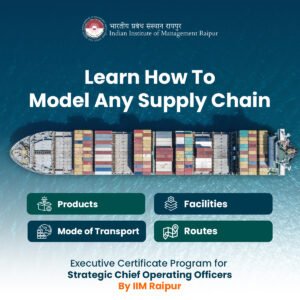Achieving excellence in supply chain management is more than a goal; it is a must. Six Sigma is a process-focused strategy established by Motorola and is one of the most potent ways of attaining excellence.
At its core, Six Sigma is a methodical approach to reducing flaws, mistakes, and variances in operations. When used in supply chain management, it becomes an effective tool for increasing efficiency, eliminating waste, and assuring constant product quality and delivery schedules.
This article delves into the critical role of Six Sigma in revolutionising supply chain management. For an in-depth insight into how organisations are reaping the benefits of Six Sigma methodology, consider signing up for supply chain certification courses.
What is the Six Sigma process?
Six Sigma is an orderly approach to workflow improvement and problem-solving aimed at eliminating faults and minimising process variability. It adheres to the DMAIC technique, implying Define, Measure, Analyse, Improve, and Control. Each step of the DMAIC process focuses on specific actions that promote improvement and accomplish desired results.
Define: The Define phase of the Six Sigma project establishes the basis for the project by thoroughly outlining the issue for improvement. It involves identifying the project’s goals, scope, and outcomes and comprehending the client’s needs and expectations. Its primary task is establishing the project charter and developing and forming a project team with specific roles and responsibilities.
Measure: The primary objective of the Measure phase is to acquire relevant data and measure the present performance of the process under consideration. This phase aims to quantify the problem and create an initial basis for future development. This phase is key to identifying crucial process parameters, gathering data using various measurement techniques, and generating process maps or flowcharts to visualise the present process progression.
Analyse: In the Analysis phase, data is analysed to determine the fundamental causes of process variances and problems. It aims to thoroughly understand the components contributing to the problem to decide which ones are impactful. Various approaches, like Pareto charts, cause-and-effect diagrams, and statistical analysis, are used to discover and prioritise probable causes.
Improve: After identifying the root causes in the Analyse phase, the Improve phase focuses on designing and implementing solutions to boost process performance. It includes developing and analysing prospective solutions, performing trials, and testing improvements to determine their utility. The objective is to optimise the process and achieve the necessary levels of efficiency.
Control: The Control phase’s objective is to maintain the benefits earned in the preceding phases by preventing the process from reverting to its prior condition. It entails designing standard operating procedures, establishing control mechanisms, and installing monitoring and measuring systems to guarantee that the process remains stable and within the required performance standards. Creating a persistent monitoring, assessment, and continuous improvement strategy is also part of the Control phase.

Benefits of Six Sigma Process in Supply Chain Management
The advantages of using the Six Sigma methodology in SCM include:
1. Quality and Customer Satisfaction
Six Sigma eliminates defects and optimises workflow, leading to superior product and service quality. Supply chain operations become more dependable and consistent by identifying and removing the fundamental cause of errors. This decrease in errors reduces waste and enhances customer satisfaction by exceeding consumer expectations. Implementing Six Sigma in the supply chain improves product quality, decreases customer complaints, and ultimately promotes healthier customer connections.
2. Enhanced Efficiency and Cost Reduction
Six Sigma’s primary tenet is to improve process efficiency by removing waste and minimising variance. This translates into simplifying procedures, lowering lead times, and optimising inventory management in the supply chain. Organisations can identify and fix bottlenecks in processes by using Six Sigma approaches, resulting in smoother operations and lower costs.
3. Increased Supply Chain Visibility
Visibility and control over all processes are important components of good supply chain management. This visibility enables proactive problem-solving, allowing organisations to detect and address problems before they worsen. Organisations can make more educated choices, forecast demand variations, and optimise inventory levels with increased supply chain insight, resulting in improved responsiveness and shorter lead times.
4. Data-Driven Decision Making
The emphasis on data analysis and measurement in Six Sigma creates a robust framework for rational choices. Supply chain specialists compile and analyse large volumes of data to detect patterns, trends, and opportunities for improvement. This analytical method helps businesses to make choices with greater clarity, reduce ambiguity, and lessen the risks associated with supply chain interruptions.
5. Supplier Collaboration and Improvement
Strong connections with suppliers and partners are essential for successful supply chain management. Six Sigma encourages teamwork by establishing distinct communication pathways and common goals. Organisations discover opportunities for process improvement, solve quality concerns, and promote continuous improvement throughout the supply chain by collaborating closely with suppliers.
Conclusion
The importance of Six Sigma in supply chain management cannot be overstated. It provides a strong framework for increasing efficiency, eliminating faults, and improving overall supply chain performance, resulting in increased customer satisfaction and a competitive advantage in the global marketplace.
Check out Imarticus Learning’s Executive Certificate Programme for Strategic Chief Operations Officers to gain an operations management certification. With this IIM Raipur supply chain operations course, you can implement data-driven programme strategies and initiatives as a COO.

